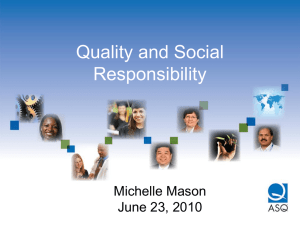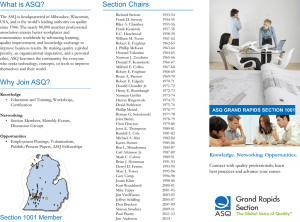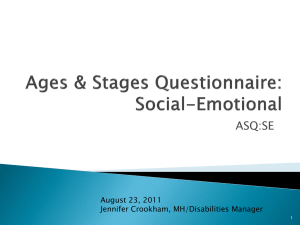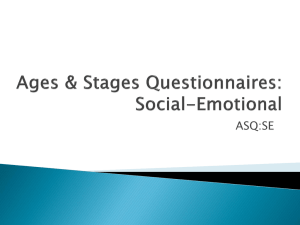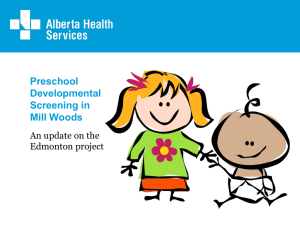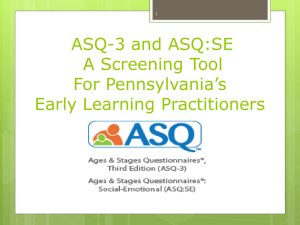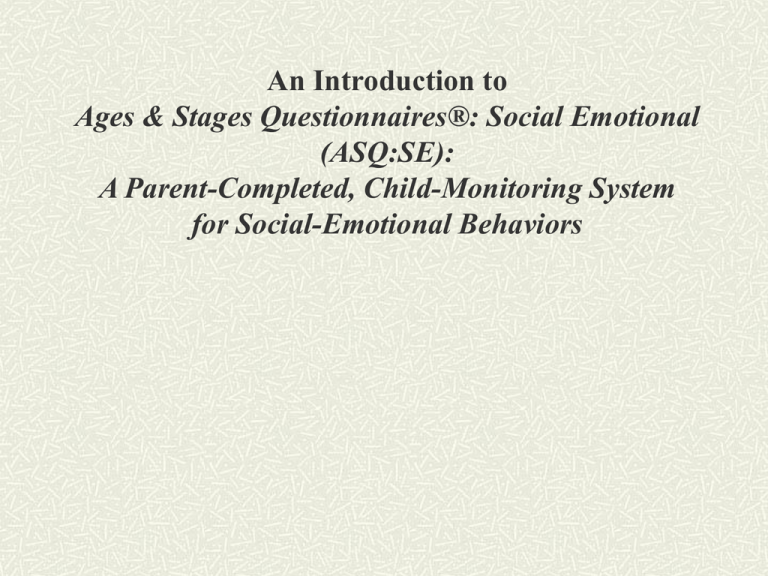
An Introduction to
Ages & Stages Questionnaires®: Social Emotional
(ASQ:SE):
A Parent-Completed, Child-Monitoring System
for Social-Emotional Behaviors
Presenter: Teri Pinto, Dept. Mental Health,
Office of Children’s Services
Alabama Assuring Better Child Health and
Development Screening Initiative
Theresa.Pinto@mh.alabama.gov
205-941-9904
Objectives
Define and discuss the benefits of developmental
screening.
Describe features of the ASQ:SE.
Score the ASQ:SE.
Describe ASQ:SE cutoff scores.
Interpret ASQ:SE information in relation to other
referral considerations.
ASQ and ASQ:SE Training Materials by Jane Squires, Jane Farrell, Jantina Clifford, Suzanne Yockelson, and Elizabeth Twombly.
Copyright © 2007 by Paul H. Brookes Publishing Co. All rights reserved.
For more information about the ASQ and ASQ:SE, go to http://www.agesandstages.com.
What is the ASQ:SE?
Parent- or caregiver-completed screening
tool that encourages parental/caregiver
involvement
Series of questionnaires for children ages 3
months to 5 ½ years
Tool to accurately identify children at risk
for social-emotional delay
ASQ and ASQ:SE Training Materials by Jane Squires, Jane Farrell, Jantina Clifford, Suzanne Yockelson, and Elizabeth Twombly.
Copyright © 2007 by Paul H. Brookes Publishing Co. All rights reserved.
For more information about the ASQ and ASQ:SE, go to http://www.agesandstages.com.
Efficacy
Test Sensitivity: 71-85%
(Need further evaluation for delay)
Specificity: 90-98%
(Probably do not have a delay)
ASQ:SE Addresses Seven Areas
ASQ and ASQ:SE Training Materials by Jane Squires, Jane Farrell, Jantina Clifford, Suzanne Yockelson, and Elizabeth Twombly.
Copyright © 2007 by Paul H. Brookes Publishing Co. All rights reserved.
For more information about the ASQ and ASQ:SE, go to http://www.agesandstages.com.
Behavioral
areas
Definition
Self-regulation
Ability/willingn ess to calm, settle, or adjust to
physiolog ical or environ mental condi tions
Complia nce
Ability/willingn ess to conform to the direction
of others and follow rules
Commun ication Verbal/nonver bal signals that indi cate
feelings, a ffect, internal states
Adaptive
Ability/success in coping with physiological
needs
Autonomy
Ability/willingn ess to establish independence
Affect
Interactions
with people
Ability/willingn ess to demonstrate feelings
and empathy for other
Ability/willingn ess to respond to or ini tiate
social responses with c aregive rs, adults, and
peers
ASQ and ASQ:SE Training Materials by Jane Squires, Jane Farrell, Jantina Clifford, Suzanne Yockelson, and Elizabeth Twombly.
Copyright © 2007 by Paul H. Brookes Publishing Co. All rights reserved.
For more information about the ASQ and ASQ:SE, go to http://www.agesandstages.com.
ASQ:SE Materials
Published by Paul H. Brookes Publishing Co.
http://www.brookespublishing.com
http://www.agesandstages.com
1-800-638-3775
Materials include
The ASQ:SE User’s Guide and ASQ:SE Questionnaires (box
set or CD)
ASQ:SE in Practice videotape
Available in English and Spanish
Case studies, questionnaires, and a technical report
about the ASQ:SE are available on the publisher’s
web site.
ASQ and ASQ:SE Training Materials by Jane Squires, Jane Farrell, Jantina Clifford, Suzanne Yockelson, and Elizabeth Twombly.
Copyright © 2007 by Paul H. Brookes Publishing Co. All rights reserved.
For more information about the ASQ and ASQ:SE, go to http://www.agesandstages.com.
Types of Assessment
Screening assessment
Diagnostic assessment
Curriculum-based (programmatic, ongoing)
assessment
ASQ and ASQ:SE Training Materials by Jane Squires, Jane Farrell, Jantina Clifford, Suzanne Yockelson, and Elizabeth Twombly.
Copyright © 2007 by Paul H. Brookes Publishing Co. All rights reserved.
For more information about the ASQ and ASQ:SE, go to http://www.agesandstages.com.
Screening Assessment
A brief assessment—similar in theory to health
screenings such as a quick hearing or vision
screen—designed to identify children who
should receive more intensive diagnosis or
evaluation from local Early Intervention (EI),
Early Childhood Special Education (ECSE),
health, and/or mental health agencies.
ASQ and ASQ:SE Training Materials by Jane Squires, Jane Farrell, Jantina Clifford, Suzanne Yockelson, and Elizabeth Twombly.
Copyright © 2007 by Paul H. Brookes Publishing Co. All rights reserved.
For more information about the ASQ and ASQ:SE, go to http://www.agesandstages.com.
Diagnostic (Professional) Assessment
An in-depth assessment of one or more
developmental areas to determine the nature
and extent of a physical or developmental
problem and determine whether the child is
eligible for services (e.g., EI).
ASQ and ASQ:SE Training Materials by Jane Squires, Jane Farrell, Jantina Clifford, Suzanne Yockelson, and Elizabeth Twombly.
Copyright © 2007 by Paul H. Brookes Publishing Co. All rights reserved.
For more information about the ASQ and ASQ:SE, go to http://www.agesandstages.com.
Curriculum-Based (Programmatic,
Ongoing) Assessment
An in-depth assessment that helps to
determine a child’s current level of
functioning. This type of assessment can
Provide a useful child profile
Help with program planning
Identify targeted goals and objectives
Be used to evaluate a child’s progress over time
ASQ and ASQ:SE Training Materials by Jane Squires, Jane Farrell, Jantina Clifford, Suzanne Yockelson, and Elizabeth Twombly.
Copyright © 2007 by Paul H. Brookes Publishing Co. All rights reserved.
For more information about the ASQ and ASQ:SE, go to http://www.agesandstages.com.
Monitoring
Developmental surveillance (screening
at frequent intervals) of at-risk infants
and toddlers not known to be eligible
for special health or educational
services; similar in theory to a person
with diabetes monitoring his or her
blood sugar
ASQ and ASQ:SE Training Materials by Jane Squires, Jane Farrell, Jantina Clifford, Suzanne Yockelson, and Elizabeth Twombly.
Copyright © 2007 by Paul H. Brookes Publishing Co. All rights reserved.
For more information about the ASQ and ASQ:SE, go to http://www.agesandstages.com.
Screening
Beyond cutoffs
Near cutoffs
Professional
assessment
Eligible for
services
Not eligible
for services
ASQ and ASQ:SE Training Materials by Jane Squires, Jane Farrell, Jantina Clifford, Suzanne Yockelson, and Elizabeth Twombly.
Copyright © 2007 by Paul H. Brookes Publishing Co. All rights reserved.
For more information about the ASQ and ASQ:SE, go to http://www.agesandstages.com.
Not near cutoffs
Continue to monitor
(rescreen) and use
curriculum-based
assessment to develop
learning plans
Incidence of Children Identified as
Having a Disability by Age
Infants: 2.4%
Preschool-age: 5.8%
School-age: 11.6%
Source: http://www.ideadata.org, 2005.
ASQ and ASQ:SE Training Materials by Jane Squires, Jane Farrell, Jantina Clifford, Suzanne Yockelson, and Elizabeth Twombly.
Copyright © 2007 by Paul H. Brookes Publishing Co. All rights reserved.
For more information about the ASQ and ASQ:SE, go to http://www.agesandstages.com.
Why Screen SocialEmotional
Behaviors?
Social-Emotional Research
Links exist between earliest emotional development
and later social behavior (Cicchetti & Cohen, 1995a,
1995b; Reynolds et al., 2001).
Behaviors, even in infancy, signal the need for
intervention (Shonkoff & Phillips, 2000).
Links exist between early risk factors, poor outcomes,
and violence (Conroy & Brown, 2004).
By third grade, programs for children with antisocial
behavior are mostly ineffective (Greenberg et al.,
2003; Walker, 2004).
ASQ and ASQ:SE Training Materials by Jane Squires, Jane Farrell, Jantina Clifford, Suzanne Yockelson, and Elizabeth Twombly.
Copyright © 2007 by Paul H. Brookes Publishing Co. All rights reserved.
For more information about the ASQ and ASQ:SE, go to http://www.agesandstages.com.
Developmental-Organizational Framework
Age
0Š12 months
S tage of de ve
lopment
At tachment
12Š30 months
Aut onomy and selfdevelopment
30 monthsŠ7 years
Establishing peer relations
Source: Cicchetti, 1993
ASQ and ASQ:SE Training Materials by Jane Squires, Jane Farrell, Jantina Clifford, Suzanne Yockelson, and Elizabeth Twombly.
Copyright © 2007 by Paul H. Brookes Publishing Co. All rights reserved.
For more information about the ASQ and ASQ:SE, go to http://www.agesandstages.com.
Be h aviors
Regulation
Recognizable states
At tachment
Communication
Differentiates between self
and others, real and makebelieve
Use of pronouns
- Exploration
Self-control; rules
Empathy
Gender differences
Identification of friends
Int erest in other children
Developmental-Organizational Framework
Age
0Š12 months
S tage of de ve
lopment
At tachment
12Š30 months
Aut onomy and selfdevelopment
30 monthsŠ7 years
Establishing peer relations
Source: Cicchetti, 1993
ASQ and ASQ:SE Training Materials by Jane Squires, Jane Farrell, Jantina Clifford, Suzanne Yockelson, and Elizabeth Twombly.
Copyright © 2007 by Paul H. Brookes Publishing Co. All rights reserved.
For more information about the ASQ and ASQ:SE, go to http://www.agesandstages.com.
Be h aviors
Regulation
Recognizable states
At tachment
Communication
Differentiates between self
and others, real and makebelieve
Use of pronouns
- Exploration
Self-control; rules
Empathy
Gender differences
Identification of friends
Int erest in other children
Developmental-Organizational Framework
Age
0Š12 months
S tage of de ve
lopment
At tachment
12Š30 months
Aut onomy and selfdevelopment
30 monthsŠ7 years
Establishing peer relations
Source: Cicchetti, 1993
ASQ and ASQ:SE Training Materials by Jane Squires, Jane Farrell, Jantina Clifford, Suzanne Yockelson, and Elizabeth Twombly.
Copyright © 2007 by Paul H. Brookes Publishing Co. All rights reserved.
For more information about the ASQ and ASQ:SE, go to http://www.agesandstages.com.
Be h aviors
Regulation
Recognizable states
At tachment
Communication
Differentiates between self
and others, real and makebelieve
Use of pronouns
- Exploration
Self-control; rules
Empathy
Gender differences
Identification of friends
Int erest in other children
Activity
What is the intent of the
questions on the ASQ:SE?
ASQ and ASQ:SE Training Materials by Jane Squires, Jane Farrell, Jantina Clifford, Suzanne Yockelson, and Elizabeth Twombly.
Copyright © 2007 by Paul H. Brookes Publishing Co. All rights reserved.
For more information about the ASQ and ASQ:SE, go to http://www.agesandstages.com.
Behavioral
areas
Definition
Self-regulation
Ability/willingn ess to calm, settle, or adjust to
physiolog ical or environ mental condi tions
Complia nce
Ability/willingn ess to conform to the direction
of others and follow rules
Commun ication Verbal/nonver bal signals that indi cate
feelings, a ffect, internal states
Adaptive
Ability/success in coping with physiological
needs
Autonomy
Ability/willingn ess to establish independence
Affect
Interactions
with people
Ability/willingn ess to demonstrate feelings
and empathy for other
Ability/willingn ess to respond to or ini tiate
social responses with c aregive rs, adults, and
peers
ASQ and ASQ:SE Training Materials by Jane Squires, Jane Farrell, Jantina Clifford, Suzanne Yockelson, and Elizabeth Twombly.
Copyright © 2007 by Paul H. Brookes Publishing Co. All rights reserved.
For more information about the ASQ and ASQ:SE, go to http://www.agesandstages.com.
ASQ:SE Features
Features of the ASQ:SE
6-, 12-, 18-, 24-, 30,- 36-, 48-, and 60-month intervals
Between 19 (6-month) and 33 (60-month) scored
questions on each questionnaire
3- to 6-month administration window on either side of
interval age
No need to use CDOB or adjusted age for children born
prematurely
ASQ and ASQ:SE Training Materials by Jane Squires, Jane Farrell, Jantina Clifford, Suzanne Yockelson, and Elizabeth Twombly.
Copyright © 2007 by Paul H. Brookes Publishing Co. All rights reserved.
For more information about the ASQ and ASQ:SE, go to http://www.agesandstages.com.
Features of ASQ:SE
Questionnaires are written at a fourth- to fifthgrade reading level.
Each questionnaire includes open-ended questions
related to eating, sleeping, and toileting.
All intervals include the question, “Is there
anything that worries you about your baby (child)?
If so, please explain.”
Each interval also includes the question, “What
things do you enjoy most about your baby (child)?”
ASQ and ASQ:SE Training Materials by Jane Squires, Jane Farrell, Jantina Clifford, Suzanne Yockelson, and Elizabeth Twombly.
Copyright © 2007 by Paul H. Brookes Publishing Co. All rights reserved.
For more information about the ASQ and ASQ:SE, go to http://www.agesandstages.com.
Features of the ASQ:SE
Competence and problem behaviors are targeted.
Externalizing and internalizing behaviors are
targeted.
Scoring Options
Most of the time
Sometimes
Never or hardly ever
Is this a concern?
Points
0 or 10
5
0 or 10
Yes = 5
High scores falling above empirically derived cutoff
points are indicative of problems.
ASQ and ASQ:SE Training Materials by Jane Squires, Jane Farrell, Jantina Clifford, Suzanne Yockelson, and Elizabeth Twombly.
Copyright © 2007 by Paul H. Brookes Publishing Co. All rights reserved.
For more information about the ASQ and ASQ:SE, go to http://www.agesandstages.com.
ASQ:SE Score Information
(N=2861)
Interval
6-month
12-month
18-month
24-month
30-month
36-month
48-month
60-month
Range
0–115
0–145
0–255
0–220
0–300
0–220
0–280
0–275
Median
16.7
25.0
26.0
28.4
35.2
35.0
36.0
35.0
ASQ and ASQ:SE Training Materials by Jane Squires, Jane Farrell, Jantina Clifford, Suzanne Yockelson, and Elizabeth Twombly.
Copyright © 2007 by Paul H. Brookes Publishing Co. All rights reserved.
For more information about the ASQ and ASQ:SE, go to http://www.agesandstages.com.
Cutoff
45
48
50
50
57
59
70
70
ASQ:SE
Case Study
Introducing the ASQ:SE to Parents
“This questionnaire asks questions about your
child’s social-emotional growth. Your
answers will help me determine what type
of information I may be able to gather for
you.”
“Some of the questions are not very specific;
just answer based on your feelings or
opinions about your child’s behavior.”
ASQ and ASQ:SE Training Materials by Jane Squires, Jane Farrell, Jantina Clifford, Suzanne Yockelson, and Elizabeth Twombly.
Copyright © 2007 by Paul H. Brookes Publishing Co. All rights reserved.
For more information about the ASQ and ASQ:SE, go to http://www.agesandstages.com.
Introducing the ASQ:SE to Parents
•
Review response options:
•
Most of the time: Child is performing behavior
most of the time or too often.
Sometimes: Child is performing behavior
occasionally but not consistently.
Rarely or never: Child is not performing or
rarely performs the behavior.
Discuss the “concerns” option.
ASQ and ASQ:SE Training Materials by Jane Squires, Jane Farrell, Jantina Clifford, Suzanne Yockelson, and Elizabeth Twombly.
Copyright © 2007 by Paul H. Brookes Publishing Co. All rights reserved.
For more information about the ASQ and ASQ:SE, go to http://www.agesandstages.com.
Administering the ASQ:SE
Have parents complete the questionnaires as
independently as possible.
Some questions on the ASQ:SE, such as
those regarding eating problems (for all
intervals) and perseverative behaviors (for
children 18 months and older) may require
clarification.
ASQ and ASQ:SE Training Materials by Jane Squires, Jane Farrell, Jantina Clifford, Suzanne Yockelson, and Elizabeth Twombly.
Copyright © 2007 by Paul H. Brookes Publishing Co. All rights reserved.
For more information about the ASQ and ASQ:SE, go to http://www.agesandstages.com.
Scoring the ASQ:SE
Determine a child’s total score:
# of questions with X ___ x 10 = ____
# of questions with V ___ x 5 = ____
# of concerns ___ x 5 = ____
Total points on each page = ____
Transfer points on each page to the ASQ:SE
Information Summary.
ASQ and ASQ:SE Training Materials by Jane Squires, Jane Farrell, Jantina Clifford, Suzanne Yockelson, and Elizabeth Twombly.
Copyright © 2007 by Paul H. Brookes Publishing Co. All rights reserved.
For more information about the ASQ and ASQ:SE, go to http://www.agesandstages.com.
ASQ:SE Omitted Item(s)
Try to obtain answers from the family.
It is okay to omit up to 2 items for the 6- to 18-month
questionnaires and up to 3 items for the 24-month and over
questionnaires.
See The ASQ:SE User’s Guide for additional guidance.
Calculation:
Step 1: Divide the total score by the number of questions answered
on the ASQ:SE. For example, 105 total points/30 questions = 3.5
points.
Step 2: Add this number, which is the average score for items on this
questionnaire, to the total score to get a new total score. For
example, 105 + 3.5 = new total score of 108.5 points.
ASQ and ASQ:SE Training Materials by Jane Squires, Jane Farrell, Jantina Clifford, Suzanne Yockelson, and Elizabeth Twombly.
Copyright © 2007 by Paul H. Brookes Publishing Co. All rights reserved.
For more information about the ASQ and ASQ:SE, go to http://www.agesandstages.com.
Review Questionnaires with
Parent(s)
Discuss the child’s strengths, and reinforce positive
parent–child interactions.
Discuss items that individually score 10 or 15 points.
Discuss answers to open-ended questions.
Review the child’s score, and compare it to the
cutoffs.
Remember that cutoffs on the ASQ:SE are very different
from those on the ASQ!
Discuss referral considerations.
ASQ and ASQ:SE Training Materials by Jane Squires, Jane Farrell, Jantina Clifford, Suzanne Yockelson, and Elizabeth Twombly.
Copyright © 2007 by Paul H. Brookes Publishing Co. All rights reserved.
For more information about the ASQ and ASQ:SE, go to http://www.agesandstages.com.
Referral Considerations
Time/setting factors
Developmental factors
Health factors
Culture/family factors
ASQ and ASQ:SE Training Materials by Jane Squires, Jane Farrell, Jantina Clifford, Suzanne Yockelson, and Elizabeth Twombly.
Copyright © 2007 by Paul H. Brookes Publishing Co. All rights reserved.
For more information about the ASQ and ASQ:SE, go to http://www.agesandstages.com.
Interpreting Scores
The “sometimes” issue
The subjectivity issue
Validity of report
Teen parents
Parents involved in protective services
First-time parents/isolated parents
Parents actively involved with drugs and alcohol
Parents with mental illness
ASQ and ASQ:SE Training Materials by Jane Squires, Jane Farrell, Jantina Clifford, Suzanne Yockelson, and Elizabeth Twombly.
Copyright © 2007 by Paul H. Brookes Publishing Co. All rights reserved.
For more information about the ASQ and ASQ:SE, go to http://www.agesandstages.com.
Questionable Scores
Have another caregiver complete the
ASQ:SE.
Gather additional information:
Observe
the child.
Use a professionally administered screening tool.
Assess parent–child interactions.
Assess the caregiving environment.
ASQ and ASQ:SE Training Materials by Jane Squires, Jane Farrell, Jantina Clifford, Suzanne Yockelson, and Elizabeth Twombly.
Copyright © 2007 by Paul H. Brookes Publishing Co. All rights reserved.
For more information about the ASQ and ASQ:SE, go to http://www.agesandstages.com.
Possible Follow-up
Below cutoff:
Provide ASQ:SE activities and monitor the
child.
Close to cutoff:
Follow up on concerns.
Provide information, education, and support.
Re-administer the ASQ:SE.
Make referrals as appropriate.
ASQ and ASQ:SE Training Materials by Jane Squires, Jane Farrell, Jantina Clifford, Suzanne Yockelson, and Elizabeth Twombly.
Copyright © 2007 by Paul H. Brookes Publishing Co. All rights reserved.
For more information about the ASQ and ASQ:SE, go to http://www.agesandstages.com.
Possible Follow-up
Above cutoff:
Refer to EI/ECSE.
Refer to local community agencies:
Feeding clinic
Church groups
Community groups, YMCA, Birth to Three
Parenting groups
Early Head Start
Refer to primary health care provider.
Refer for mental health evaluation.
ASQ and ASQ:SE Training Materials by Jane Squires, Jane Farrell, Jantina Clifford, Suzanne Yockelson, and Elizabeth Twombly.
Copyright © 2007 by Paul H. Brookes Publishing Co. All rights reserved.
For more information about the ASQ and ASQ:SE, go to http://www.agesandstages.com.
Communicating Screening Results
Assure the family that the discussion is confidential.
Review the purpose of screening.
Avoid terms such as test, pass, or fail. (instead, use
below cutoff or near cutoff)
Review the ASQ:SE and explain area scores.
Emphasize child and family strengths.
Provide specific examples of concerns.
Invite parents to share their observations and/or
concerns.
ASQ and ASQ:SE Training Materials by Jane Squires, Jane Farrell, Jantina Clifford, Suzanne Yockelson, and Elizabeth Twombly.
Copyright © 2007 by Paul H. Brookes Publishing Co. All rights reserved.
For more information about the ASQ and ASQ:SE, go to http://www.agesandstages.com.
Communicating Screening Results*
Prepare for the meeting carefully:
Make notes about behaviors.
Note information you need to gather (e.g., health
history) from the family.
Role-play the conversation with a peer.
Select a private, comfortable place to meet.
Consider cultural or language issues.
Know your community resources.
Be calm!
* Source: Hilton/Early Head Start Training Program, Sonoma State University
ASQ and ASQ:SE Training Materials by Jane Squires, Jane Farrell, Jantina Clifford, Suzanne Yockelson, and Elizabeth Twombly.
Copyright © 2007 by Paul H. Brookes Publishing Co. All rights reserved.
For more information about the ASQ and ASQ:SE, go to http://www.agesandstages.com.
Infant Mental Health Interventions
Deborah Weatherston
Wayne State University, Merrill-Palmer Institute
1. Concrete service assessment or assistance
2. Emotional support
3. Developmental guidance
4. Early developing relationship support
5. Infant–parent psychotherapy**
6. Advocacy
**Requires a trained mental health professional
ASQ and ASQ:SE Training Materials by Jane Squires, Jane Farrell, Jantina Clifford, Suzanne Yockelson, and Elizabeth Twombly.
Copyright © 2007 by Paul H. Brookes Publishing Co. All rights reserved.
For more information about the ASQ and ASQ:SE, go to http://www.agesandstages.com.
The ASQ:SE
User’s Guide
Excellent resource
Includes information on
scoring and interpreting
scores
Provides activities and
case studies
Covers all topics in depth
ASQ and ASQ:SE Training Materials by Jane Squires, Jane Farrell, Jantina Clifford, Suzanne Yockelson, and Elizabeth Twombly.
Copyright © 2007 by Paul H. Brookes Publishing Co. All rights reserved.
For more information about the ASQ and ASQ:SE, go to http://www.agesandstages.com.
Summary
Screening tools can help bridge communication with
families.
Screening tools can assist in making referrals to
community agencies.
Referrals should be based on a variety of considerations
in addition to scores.
Social-emotional issues are very complicated.
Use available resources to make decisions about what
steps to take after screening.
ASQ and ASQ:SE Training Materials by Jane Squires, Jane Farrell, Jantina Clifford, Suzanne Yockelson, and Elizabeth Twombly.
Copyright © 2007 by Paul H. Brookes Publishing Co. All rights reserved.
For more information about the ASQ and ASQ:SE, go to http://www.agesandstages.com.
For more information,
please contact:
Jane Squires, Ph.D.,
Jantina Clifford, Ph.D., or
Liz Twombly, M.S.
University of Oregon
541-346-0807
http://eip.uoregon.edu

